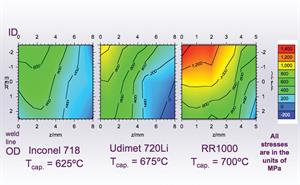Modern aircraft incorporate a range of high-performance alloys – both as engine and body components – which are designed to withstand high temperatures or to combine lightness and durability. Equally advanced methods are required to join the materials together.
In particular, nickel-based ‘superalloys’ are used in aero-engines because they maintain their considerable strength at high operating temperatures. However, they are extremely difficult to join using conventional fusion-welding techniques. A preferred method is to exploit friction to generate enough local heating so that the two metal components are softened in the weld region – but without melting.

Residual hoop stresses measured on Engin-x in the as-welded condition in three different alloys
View full-size image
In one version of friction welding, a circular workpiece, driven by a flywheel, is rotated at a specific speed against a second component. The resulting inertial friction welds are found in Rolls Royce’s new generation of aero-engines – the Trent 800 and 900 which respectively power the Airbus 380 and Boeing 787.
However, the friction approach may introduce residual stresses – which can weaken the join. It is important, therefore, to optimise the welding conditions, and subsequent post-weld heat treatment, to relieve the stresses.
Stress management
Fortunately, neutron diffraction provides the perfect tool for mapping residual stresses. Any elastic deformation alters the distances between atomic planes in the material’s crystal lattice – which, in effect, acts like a miniature strain gauge; the changes are revealed in the diffraction pattern.
Michael Preuss and colleagues at the University of Manchester, in collaboration with Rolls Royce, have been mapping the stresses in a number of welds using ISIS instruments ENGIN and its successor ENGIN-X. The instrumentation is specifically designed for engineering applications and can even accommodate full-sized components.
The researchers were able to map residual stresses in development welds and in a life-size component. The measurements highlighted the different stress levels generated by the same process but in different alloys. The work also helped Rolls Royce decide on the most suitable post-weld heat treatment.
Welding dissimilar materials is becoming increasingly important. In another project, the Manchester group mapped the stresses around weld lines between two types of aluminium alloys used to construct light aircraft. A new technique called friction stir-welding, in which a rotating tool heats and ‘stirs’ the interface between two touching edges, is increasingly used instead of expensive riveting. The results indicated the importance of the tool’s rotation speed in getting the best weld.
Dr Michael Preuss et al (Manchester University)
michael.preuss@manchester.ac.uk
Research date: December 2006
Further Information
A comparison of inertial friction welds in three nickel base superalloys, M Preuss, PJ Withers and GJ Baxter, Materials Science and Engineering A 437 (2006) 38.
Dissimilar friction stir welds in AA5083-AA6082: The effect of process parameters on residual stress, A Streuwer, MJ Peel and PJ Withers, Materials Science and Engineering A, 441 (2006) 187.
